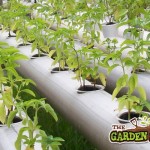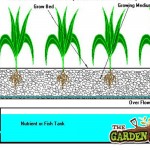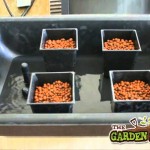The first thing to mention is that ebb and flow hydroponics systems is just one of 3 commonly used systems. Other systems include the wick system and the Nutrient Film Techinque (NFT). Each of the three have their own merits, but the ebb and flow system is the most reliable as it probably is the easiest to set up
- more hydroponics
- Ebb and flow Diagram
- Ebb and flow in Action
What you need to set up an ebb & Flow hydroponic System:
Root Chamber
Reservoir
Water fountain Pump
Pipeline for pump
Timer for the pump
An over flow outlet
The ebb and flow hydroponics is a model based on a flood and drain watering system. The root chamber is periodically filled with water (flood), as the water reaches the set height of the overflow outlet the water filters back down into the reservoir (drained). The cycle continues until the pump times off. The water that sits in the root chamber can be utilised by the plants until all has been used up.
Setting up an ebb and flow hydroponics
The Root Chamber
This should be a large, wide and deep basin. The size will depend on what and how many plants you wish to grow. To grow 6 tomato plants one basin of approx. 80cm x 120cm x 15cm in depth. Such a tray can be difficult to source but sometimes kids paddling pools, storage boxes or plastic ponds are used. It is inside the root chamber that the plants and the plant roots will sit. These plants need to be supported in position inside the root chamber
The Reservoir
The shape of the reservoir doesn’t matter, and it doesn’t really need to be too big. To determine the volume of water required just measure the size of the chamber times the height to the overflow valve and add an amount to ensure there is sufficient water in the reservoir at all times to feed the pump. Ideally the reservoir should be dark in colour to prevent algae forming and also it should have a lid to prevent dirt falling in and clogging the pump
The Pump
A basic pump should be sufficient. There are two important factors regarding the choice of pump:
1. The flow rate: this is the gallons or litre per hour. This will determine the amount of water the pump will pump and this will determine how long you then the pump to run for to add a sufficient amount of water to the chamber
2. The head height: This is the strength of the pump and is a measure of how high the pump can pump water against gravity. This is important if your chamber is positioned up high above the reservoir
The Timer
When choosing a timer make sure that is has the suitable settings. For a basic hydroponic system the timer needs to have separate run frequencies and run time lengths
The overflow valve
This essential to complete the water flow and to drain the root chamber. The over flow valve needs to be fitted to the side of the chamber at the necessary height to allow the suitable amount of water to sit in the chamber. The suitable amount is the amount of water where the plants won’t drowned and where they won’t dry out from insufficient water.
Each system is unique due to many factors of size and plant type and so each system needs to be calibrated differently. Trail and error may be required to determine the right frequency of water flow and for how long the water will flow
Plant pot supports
There are a few ways to support your plant pots in the root chamber. As you cannot adjust the height of the over flow valve you may instead adjust the height of the pots within the root chamber. As he plants grow and require more water they can be lowered into the root chamber
1. Using hydroclea pellets – fill the base of the chamber to increase the height of your plant pots. Later remove some pellets to lower the pots into the water
2. Use Aero board – These frames can be placed around the plant pots so that they float in the water keeping the small pots up above the water line
3. Using a raised platform. These can be used to keep smaller plant pot up out of the water. Again remove once larger plants and pots are being used in the chamber


